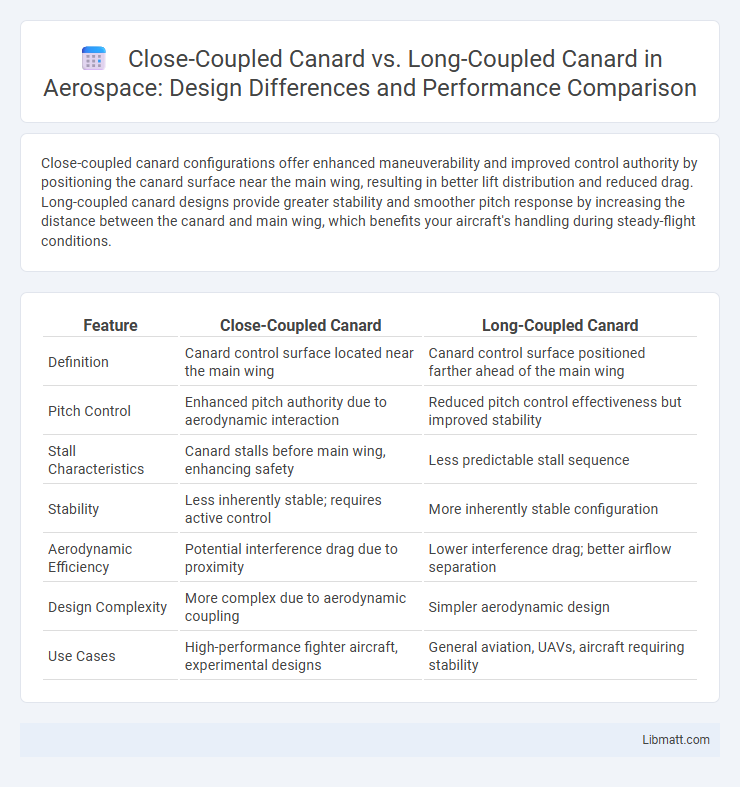Close-coupled canard configurations offer enhanced maneuverability and improved control authority by positioning the canard surface near the main wing, resulting in better lift distribution and reduced drag. Long-coupled canard designs provide greater stability and smoother pitch response by increasing the distance between the canard and main wing, which benefits your aircraft's handling during steady-flight conditions.
Table of Comparison
| Feature | Close-Coupled Canard | Long-Coupled Canard |
|---|---|---|
| Definition | Canard control surface located near the main wing | Canard control surface positioned farther ahead of the main wing |
| Pitch Control | Enhanced pitch authority due to aerodynamic interaction | Reduced pitch control effectiveness but improved stability |
| Stall Characteristics | Canard stalls before main wing, enhancing safety | Less predictable stall sequence |
| Stability | Less inherently stable; requires active control | More inherently stable configuration |
| Aerodynamic Efficiency | Potential interference drag due to proximity | Lower interference drag; better airflow separation |
| Design Complexity | More complex due to aerodynamic coupling | Simpler aerodynamic design |
| Use Cases | High-performance fighter aircraft, experimental designs | General aviation, UAVs, aircraft requiring stability |
Introduction to Canard Configurations
Close-coupled canard configurations feature the canard surface positioned near the main wing, improving pitch control and delaying stall by creating beneficial aerodynamic interactions. Long-coupled canard designs place the canard farther from the main wing, offering greater control authority and stability at various angles of attack. Your choice between these configurations depends on desired handling characteristics and performance trade-offs in aircraft design.
Defining Close-Coupled and Long-Coupled Canards
Close-coupled canards are aerodynamic surfaces positioned near the main wing, enhancing lift and stability by influencing airflow immediately ahead of the wing. Long-coupled canards, however, are placed farther forward, providing distinct control authority and improved pitch control due to increased moment arm length. Your choice between close-coupled and long-coupled canard configurations affects aircraft handling and aerodynamic performance based on design goals.
Historical Development of Canard Arrangements
Close-coupled and long-coupled canard configurations evolved through decades of aerodynamic research aimed at enhancing stability and control in aircraft design. Early experiments during the 1920s and 1930s favored long-coupled canards for improved pitch control, while later developments in the 1970s and 1980s, prompted by advances in computational fluid dynamics, popularized close-coupled canards for their benefits in lift distribution and maneuverability. Understanding these historical shifts can inform your choice in aircraft design or analysis by recognizing how each canard arrangement optimizes stability and performance depending on the specific application.
Aerodynamic Principles of Canard Designs
Close-coupled canards generate strong vortex lift by positioning the canard surface near the main wing, improving maneuverability and delaying stall through favorable airflow interaction. Long-coupled canards, placed further from the wing, provide more independent control surfaces, enhancing stability but reducing vortex interaction and lift augmentation. Your choice depends on balancing agility with control stability, influenced by sectional lift distribution and aerodynamic moments in flight dynamics.
Stability and Control: Close-Coupled vs Long-Coupled
Close-coupled canard configurations enhance pitch stability by positioning the canard surface close to the main wing, enabling more effective control surface interactions and rapid response to pilot inputs. Long-coupled canards offer increased control authority and smoother handling at various angles of attack but may introduce delayed pitch response due to greater aerodynamic moment arms. Your choice affects the aircraft's stability margin and control sensitivity, influencing maneuverability and overall flight characteristics.
Maneuverability and Lift Characteristics
Close-coupled canards significantly enhance maneuverability by generating strong vortices that increase lift and delay stall on the main wing, allowing for tighter turns and improved control at high angles of attack. In contrast, long-coupled canards provide more stable lift characteristics with smoother airflow separation, offering greater longitudinal stability but slightly less agility in quick maneuvers. Your aircraft's design choice between these configurations will directly impact responsiveness and aerodynamic efficiency during various flight conditions.
Application in Modern Aircraft Design
Close-coupled canards enhance maneuverability and control at low speeds by positioning the canard surfaces near the main wing, optimizing aerodynamic lift distribution in modern fighter jets like the Eurofighter Typhoon. Long-coupled canards, spaced farther from the main wing, provide improved stability and pitch control, benefiting aircraft requiring steady flight characteristics, such as some unmanned aerial vehicles and advanced trainer aircraft. Both configurations contribute to reduced drag and improved efficiency, allowing designers to tailor stability and agility based on specific performance requirements in contemporary aerospace engineering.
Comparative Performance Analysis
Close-coupled canards enhance pitch control and reduce trim drag by positioning the canard surfaces near the main wing, resulting in improved maneuverability and stall resistance. Long-coupled canards, spaced further from the wing, offer greater stability and control authority at varying angles of attack but may increase drag and reduce overall efficiency. Your choice between these configurations should consider the specific aerodynamic goals, such as prioritizing agility or stability in the aircraft's performance profile.
Advantages and Disadvantages of Each Configuration
Close-coupled canards offer enhanced maneuverability and improved pitch control by positioning the canard surfaces near the main wing, resulting in reduced drag and better lift distribution. However, they may suffer from complex aerodynamic interactions and reduced stability at high angles of attack. Long-coupled canards provide greater stability and smoother airflow between the canard and main wing, but typically experience increased drag and less responsive pitch control, which may impact your aircraft's agility.
Future Trends in Canard Implementation
Future trends in canard implementation focus on advanced aerodynamic efficiency and enhanced maneuverability, with close-coupled canards offering improved lift and reduced drag through optimized vortex interaction. Long-coupled canards provide greater stability and control authority at various flight regimes, making them suitable for next-generation unmanned aerial vehicles (UAVs) and stealth aircraft designs. Your choice between these configurations will depend on the specific performance goals and integration requirements of emerging aerospace technologies.
Close-coupled canard vs Long-coupled canard Infographic

 libmatt.com
libmatt.com